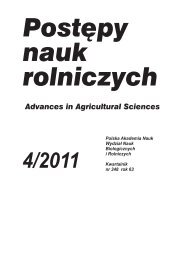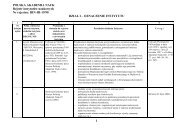Postepy nauk rolniczych - Instytucja Naukowa - Polska Akademia ...
Postepy nauk rolniczych - Instytucja Naukowa - Polska Akademia ...
Postepy nauk rolniczych - Instytucja Naukowa - Polska Akademia ...
Create successful ePaper yourself
Turn your PDF publications into a flip-book with our unique Google optimized e-Paper software.
28 J. Syller, A. Kaliciak<br />
Literatura<br />
[1] Beczner L., Horváth J., Romhányi I., Förster H. 1984. Studies on the etiology of tuber necrotic ringspot disease<br />
in potato. Potato Res. 27: 339–352.<br />
[2] Blackman R.L., Eastop V.F. 2000. Aphids on the world’s crops: An identification and information guide. 2 nd<br />
edition. John Wiley & Sons Ltd., Chichester: 466 ss.<br />
[3] Boydston R.A., Mojtahedi H., Crosslin J.M., Brown C.R., Anderson T. 2008. Effect of hairy nightshade<br />
(Solanum sarrachoides) presence on potato nematodes, diseases, and insect pests. Weed Sci. 56: 151–154.<br />
[4] Brault V., Uzest M., Monsion B., Jacquot E., Blanc S. 2010. Aphids as transport devices for plant viruses. C.R.<br />
Biologies 333: 524–538.<br />
[5] Brunt A.A., Loebenstein G. 2001. The main viruses infecting potato crops. W: Virus and virus-like diseases of<br />
potatoes and production of seed-potatoes. Loebenstein G., Berger P.H., Brunt A.A., Lawson R.H. (red.). Kluwer<br />
Academic Publishers, Dordrecht: 65–105.<br />
[6] Capinera J. 2001. Green peach aphid, Myzus persicae (SULZER)(Insecta: Hemiptera: Aphididae). EENY-222,<br />
University of Florida: IFAS Extension.<br />
[7] Chatzivassiliou E.K., Boubourakas I., Drossos E., Eleftherohorinos I., Jenser G., Peters D., Katis N.I. 2001.<br />
Weeds in greenhouses and tobacco fields are differentially infected by Tomato spotted wilt virus and infested by<br />
its vector species. Plant Dis. 85: 40–46.<br />
[8] Chatzivassiliou E.K., Efthimiou K., Drossos E., Papadopoulou A., Poimenidis G., Katis N.I. 2004. A survey of<br />
tobacco viruses in tobacco crops and native flora in Greece. Eur. J. Plant Pathol. 110: 1011–1023.<br />
[9] Chatzivassiliou E.K., Moschos E., Gazi S., Koutretsis P., Tsoukaki M. 2008. Infection of potato crops and seeds<br />
with Potato virus Y and Potato leafroll virus in Greece. J. Plant Pathol. 90: 253–261.<br />
[10] Chikh Ali M., Maoka T., Natsuaki T., Natsuaki K.T. 2010. PVY NTN-NW , a novel recombinant strain of Potato<br />
virus Y predominating in Syria. Plant Pathol. 59: 31–41.<br />
[11] Chrzanowska M. 1991. New isolates of the necrotic strain of potato virus Y (PVYN) found recently in Poland.<br />
Potato Res. 34: 179–182.<br />
[12] Chrzanowska M. 2004. Wirusy ziemniaka, nasilenie wystêpowania, zachodz¹ce zmiany i ich przyczyny. Mat.<br />
konf. <strong>nauk</strong>. „Nasiennictwo i ochrona ziemniaka”. Ko³obrzeg, 4–5 marca 2004: 53–56.<br />
[13] Elena S.F., Froissart R. 2010. New experimental and theoretical approaches towards the understanding of the<br />
emergence of viral infections. Phil. Trans. R. Soc. B 365: 1867–1869.<br />
[14] Fereres A., Moreno A. 2009. Behavioural aspects influencing plant virus transmission by homopteran insects.<br />
Virus Res. 141: 158–168.<br />
[15] Fletcher J.D. 2001. New hosts of Alfalfa mosaic virus, Cucumber mosaic virus, Potato virus Y, Soybean dwarf<br />
virus, and Tomato spotted wilt virus in New Zealand. New Zealand J. Crop Hortic. Sci. 29: 213–217.<br />
[16] Francis F., Gerkens P., Harmel N., Mazzucchelli G., de Pauw E., Haubruge E. 2006. Proteomics in Myzus<br />
persicae: Effect of aphid host plant switch. Insect Bioch. Mol. Biol. 36: 219–227.<br />
[17] Garcia-Arenal F., Fraile A., Malpica J.M. 2003. Variation and evolution of plant virus populations. Int.<br />
Microbiol. 6: 225–232.<br />
[18] G³owaciñski Z., Okarma H., Paw³owski J., Solarz W. (red.) 2008. Ksiêga gatunków obcych inwazyjnych<br />
w faunie Polski. Wyd. internetowe. Instytut Ochrony Przyrody PAN w Krakowie.<br />
[19] Goliszewski W. 2009. Ekologiczne nasiennictwo ziemniaka – argumenty za i przeciw. Wieœ Jutra 2(127): 35–36.<br />
[20] Hohn T. 2007. Plant virus transmission from the insect point of view. Proc. Natl. Acad. Sci. USA 104(46):<br />
17905–17906.<br />
[21] Horvath J., Gaborjanyi R., Kazinczi G., Takacs A.P. 2001. Natural occurrence of Tomato spotted wilt virus<br />
(TSWV) on potato in Hungary. Növénytermelés 505: 545–548.<br />
[22] Jenser G. 2008. Relationships among virus vector Thysanoptera species, Tomato spotted wilt virus and their<br />
cultivated and wild growing plants in Palaearctic. Acta Phytopathol. Entomol. Hung. 43: 283–288.<br />
[23] Jones R.A.C. 2009. Plant virus emergence and evolution: Origins, new encounter scenarios, factors driving<br />
emergence, effects of changing world conditions, and prospects for control. Virus Res. 141: 113–130.<br />
[24] Kahn N.D., Walgenbach J.F., Kennedy G.G. 2005. Summer weeds as hosts for Frankliniella occidentalis and<br />
Frankliniella fusca (Thysanoptera: Thripidae) and as reservoirs for Tomato spotted wilt tospovirus in North<br />
Carolina. J. Econ. Entomol. 98: 1810–1815.<br />
[25] Kaliciak A., Syller J. 2009. Przenoszenie ró¿nych genetycznie izolatów wirusa Y ziemniaka przez mszyce<br />
i podatnoœæ chwastów na infekcjê wirusem. Biul. IHAR 253: 285–295.

















